This article needs additional citations for verification .(February 2021) |


Nikolaus Lilienfeld (also Nicolaus Lillienveld, Nikolaus Lillienfeld) was a German engineer and clockmaker of the late 14th and early 15th centuries.
This article needs additional citations for verification .(February 2021) |


Nikolaus Lilienfeld (also Nicolaus Lillienveld, Nikolaus Lillienfeld) was a German engineer and clockmaker of the late 14th and early 15th centuries.
The circumstances of Lilienfeld's life are largely unknown. It is assumed that he was born between 1350 and 1365 and died between 1420 and 1435. The place of Lilienfeld's birth or death is unknown.
Lilienfeld is first attested in late 1394, when he completed the astronomical clock in Stralsund. In 1396, he was named in two Rostock records as a witness to the notarisation in connection with the founding of the Marienehe Charterhouse in Rostock; in 1406, he worked as a hydraulic engineer for the Marienkron Monastery near Rügenwalde and in 1420, he received a financial grant for the construction of a water pipe for the city of Stralsund.
Lilienfeld's importance results from the fact that he built the astronomical clock in St. Nicholas Church, Stralsund. This makes him the oldest clockmaker known by name in the Baltic region. The clock he constructed bears the Latin inscription:
Lilienfeld probably had no academic education, but was skilled in the use of astronomical instruments. His indication of the latitude of Stralsund on the dial of the Stralsund clock with 54 degrees 25 minutes is of astonishing accuracy.
The clock case also bears a portrait of Lilienfeld on the southern side wall, the oldest portrait of a clockmaker ever.
Due to similarities of preserved parts with the corresponding elements of the Stralsund clock, it is assumed that Lilienfeld also built the astronomical clock of Doberan Minster, of which only the dial remains today, as well as the clock in Lund Cathedral, which is no longer in its original state. However, there is no written evidence for this assumption.
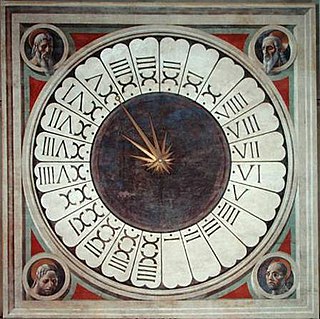
A clock or a timepiece is a device used to measure and indicate time. The clock is one of the oldest human inventions, meeting the need to measure intervals of time shorter than the natural units such as the day, the lunar month and the year. Devices operating on several physical processes have been used over the millennia.

A cuckoo clock is, typically, a pendulum clock that strikes the hours with a sound like a common cuckoo call and has an automated cuckoo bird that moves with each note. Some move their wings and open and close their beaks while leaning forwards, whereas others have only the bird's body leaning forward. The mechanism to produce the cuckoo call has been in use since the middle of the 1700s and has remained almost without variation.

Lund Cathedral is a cathedral of the Lutheran Church of Sweden in Lund, Scania, Sweden. It is the seat of the Bishop of Lund and the main church of the Diocese of Lund. It was built as the Catholic cathedral of the archiepiscopal see of all the Nordic countries, dedicated to Saint Lawrence. It is one of the oldest stone buildings still in use in Sweden.

The Prague Astronomical Clock or Prague Orloj is a medieval astronomical clock attached to the Old Town Hall in Prague, the capital of the Czech Republic.
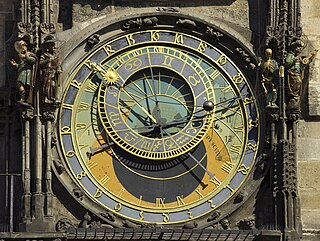
An astronomical clock, horologium, or orloj is a clock with special mechanisms and dials to display astronomical information, such as the relative positions of the Sun, Moon, zodiacal constellations, and sometimes major planets.
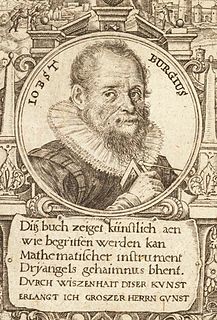
Jost Bürgi, active primarily at the courts in Kassel and Prague, was a Swiss clockmaker, a maker of astronomical instruments and a mathematician.

Thomas Tompion, FRS (1639–1713) was an English clockmaker, watchmaker and mechanician who is still regarded to this day as the "Father of English Clockmaking". Tompion's work includes some of the most historic and important clocks and watches in the world, and can command very high prices whenever outstanding examples appear at auction. A plaque commemorates the house he shared on Fleet Street in London with his equally famous pupil and successor George Graham.
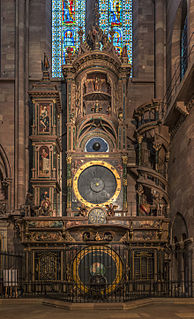
The Strasbourg astronomical clock is located in the Cathédrale Notre-Dame of Strasbourg, Alsace, France. It is the third clock on that spot and dates from the time of the first French possession of the city (1681–1870). The first clock had been built in the 14th century, the second in the 16th century, when Strasbourg was a Free imperial city of the Holy Roman Empire.

Rasmus Jonassen Sørnes, was a Norwegian inventor, clockmaker and radio technician, and is most famous for his advanced astronomical clocks, the most precise of which has an inaccuracy of 7 seconds during 1000 years. During his lifetime, Sørnes also designed and built a large variety of agricultural, radio-technical and mechanical devices, only a few of them patented.
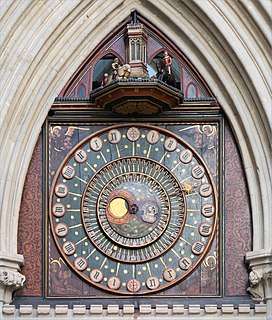
The Wells Cathedral clock is an astronomical clock in the north transept of Wells Cathedral, England. The clock is one of the group of famous 14th to 16th century astronomical clocks to be found in the West of England. The surviving mechanism, dated to between 1386 and 1392, was replaced in the 19th century, and was eventually moved to the Science Museum in London, where it continues to operate. The dial represents the geocentric view of the universe, with Sun and Moon revolving round a central fixed Earth. It may be unique in showing a philosophical model of the pre-Copernican universe.
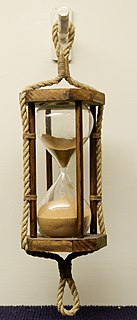
The history of timekeeping devices dates back to when ancient civilizations first observed astronomical bodies as they moved across the sky. Devices and methods for keeping time have since then improved through a long series of new inventions and ideas. Sundials and water clocks originated from ancient Egypt, and were later used by the Babylonians, the Greeks and the Chinese; medieval Islamic water clocks were unrivalled in their sophistication until the mid-14th century. Incense clocks, which may have been invented in India, were being used in China by the 6th century. The hourglass, one of the few reliable methods of measuring time at sea, was a European invention and does not seem to have been used in China before the mid-16th century.
Vitslav II, variously called Vislav, Vizlav, Wislaw, Wizlaw and Witslaw in English sources was a prince of Rügen.
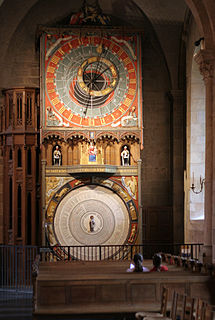
Lund astronomical clock, occasionally and at least since the 16th century referred to as Horologium mirabile Lundense, is a 15th-century astronomical clock in Lund Cathedral. Mentioned in written sources for the first time in 1442, it was probably made and installed sometime around 1423–25, possibly by Nikolaus Lilienfeld. It is part of a group of related medieval astronomical clocks found in the area around the south Baltic Sea. In 1837 the clock was dismantled. Between 1909 and 1923, it was restored by the Danish clockmaker Julius Bertram-Larsen and the Swedish architect responsible for the upkeep of the cathedral, Theodor Wåhlin. From the old clock, the face of the clock as well as the mechanism, which was largely replaced during the 18th century, was salvaged and re-used. The casing, most parts of the calendar which occupies the lower part, and the middle section were made anew.

St. Nicholas Church is the oldest of the three major parish churches of the Hanseatic city of Stralsund in Germany. It was dedicated in 1279 to St. Nicholas of Myra, the patron saint of sailors. Since 1524 it is an Evangelical Lutheran church. It is one of the earliest examples of the introduction of the cathedral pattern of northern France into the Brick Gothic architecture of the Baltic region. As part of the historic centre of Stralsund, St. Nicholas Church was inscribed on the UNESCO World Heritage List in 2002.

Bartholomäus Sastrow, sometimes anglicised Bartholomew, was a German official, notary, and mayor of Stralsund. He left a culturally and historically important autobiography, written in 1595 when he was 75 years of age. There is a plaque marking the site of his birth at Lange Straße 54 in Greifswald.

A computus clock is a clock equipped with a mechanism that automatically calculates and displays, or helps determine, the date of Easter. A computus watch carries out the same function.
Manfred Schukowski is a German academic teacher and author of works on astronomical clocks.

The Münster astronomical clock is an astronomical clock in Münster Cathedral in Münster, Germany.
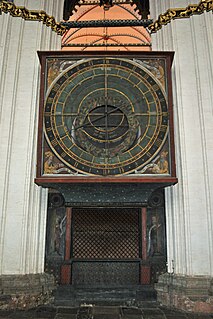
The astronomical clock of St. Nicholas Church, Stralsund is a 14th century monumental astrolabe clock. It was probably damaged in the 16th century, and has not worked since then. It is the only clock of its kind to have been preserved almost entirely in its original condition. The clockwork and the indications have not been restored.